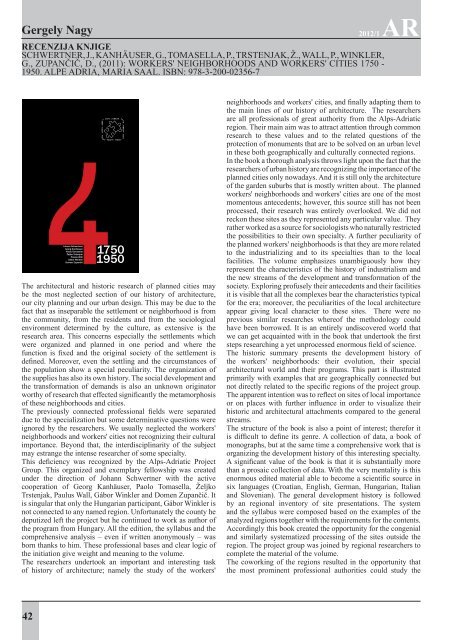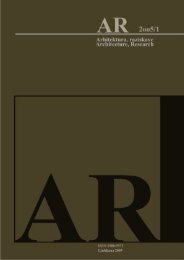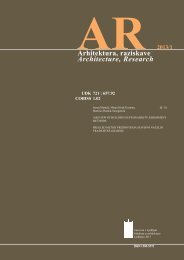2o12/1 - Fakulteta za arhitekturo - Univerza v Ljubljani
2o12/1 - Fakulteta za arhitekturo - Univerza v Ljubljani
2o12/1 - Fakulteta za arhitekturo - Univerza v Ljubljani
Create successful ePaper yourself
Turn your PDF publications into a flip-book with our unique Google optimized e-Paper software.
th9 mm folding11 mm backGergely Nagy2012/1 ARRecenzija knjigeSchwertner, J., Kanhäuser, G., Tomasella, P., Trstenjak, Ž., Wall, P., Winkler,G., Zupančič, D., (2011): Workers' neighborhoods and workers' cities 1750 -1950. Alpe Adria, Maria Saal. ISBN: 978-3-200-02356-79 mm foldingCover design: Alpe Adria 4 ReportDesigner: Domen ZupančičDate: 6 Sept 2011Info: domen.zupancic@fa.uni-lj.si // 00 386 41 795 267213 mm1750 195017501950The architectural and historic research of planned cities maybe the most neglected section of our history of architecture,our city planning and our urban design. This may be due to thefact that as inseparable the settlement or neighborhood is fromthe community, from the residents and from the sociologicalenvironment determined by the culture, as extensive is theresearch area. This concerns especially the settlements whichwere organized and planned in one period and where thefunction is fixed and the original society of the settlement isdefined. Moreover, even the settling and the circumstances ofthe population show a special peculiarity. The organi<strong>za</strong>tion ofthe supplies has also its own history. The social development andthe transformation of demands is also an unknown originatorworthy of research that effected significantly the metamorphosisof these neighborhoods and cities.The previously connected professional fields were separateddue to the speciali<strong>za</strong>tion but some determinative questions wereignored by the researchers. We usually neglected the workers'neighborhoods and workers' cities not recognizing their culturalimportance. Beyond that, the interdisciplinarity of the subjectmay estrange the intense researcher of some specialty.This deficiency was recognized by the Alps-Adriatic ProjectGroup. This organized and exemplary fellowship was createdunder the direction of Johann Schwertner with the activecooperation of Georg Kanhäuser, Paolo Tomasella, ŽeljkoTrstenjak, Paulus Wall, Gábor Winkler and Domen Zupančič. Itis singular that only the Hungarian participant, Gábor Winkler isnot connected to any named region. Unfortunately the county hedeputized left the project but he continued to work as author ofthe program from Hungary. All the edition, the syllabus and thecomprehensive analysis – even if written anonymously – wasborn thanks to him. These professional bases and clear logic ofthe initiation give weight and meaning to the volume.The researchers undertook an important and interesting taskof history of architecture; namely the study of the workers'neighborhoods and workers' cities, and finally adapting them tothe main lines of our history of architecture. The researchersare all professionals of great authority from the Alps-Adriaticregion. Their main aim was to attract attention through commonresearch to these values and to the related questions of theprotection of monuments that are to be solved on an urban levelin these both geographically and culturally connected regions.In the book a thorough analysis throws light upon the fact that theresearchers of urban history are recognizing the importance of theplanned cities only nowadays. And it is still only the architectureof the garden suburbs that is mostly written about. The plannedworkers' neighborhoods and workers' cities are one of the mostmomentous antecedents; however, this source still has not beenprocessed, their research was entirely overlooked. We did notreckon these sites as they represented any particular value. Theyrather worked as a source for sociologists who naturally restrictedthe possibilities to their own specialty. A further peculiarity ofthe planned workers' neighborhoods is that they are more relatedto the industrializing and to its specialties than to the localfacilities. The volume emphasizes unambiguously how theyrepresent the characteristics of the history of industrialism andthe new streams of the development and transformation of thesociety. Exploring profusely their antecedents and their facilitiesit is visible that all the complexes bear the characteristics typicalfor the era; moreover, the peculiarities of the local architectureappear giving local character to these sites. There were noprevious similar researches whereof the methodology couldhave been borrowed. It is an entirely undiscovered world thatwe can get acquainted with in the book that undertook the firststeps researching a yet unprocessed enormous field of science.The historic summary presents the development history ofthe workers' neighborhoods: their evolution, their specialarchitectural world and their programs. This part is illustratedprimarily with examples that are geographically connected butnot directly related to the specific regions of the project group.The apparent intention was to reflect on sites of local importanceor on places with further influence in order to visualize theirhistoric and architectural attachments compared to the generalstreams.The structure of the book is also a point of interest; therefor itis difficult to define its genre. A collection of data, a book ofmonographs, but at the same time a comprehensive work that isorganizing the development history of this interesting specialty.A significant value of the book is that it is substantially morethan a prosaic collection of data. With the very mentality is thisenormous edited material able to become a scientific source insix languages (Croatian, English, German, Hungarian, Italianand Slovenian). The general development history is followedby an regional inventory of site presentations. The systemand the syllabus were composed based on the examples of theanalyzed regions together with the requirements for the contents.Accordingly this book created the opportunity for the congenialand similarly systematized processing of the sites outside theregion. The project group was joined by regional researchers tocomplete the material of the volume.The coworking of the regions resulted in the opportunity thatthe most prominent professional authorities could study the42

















